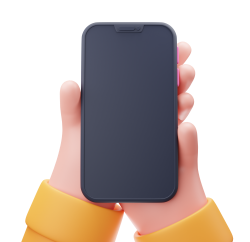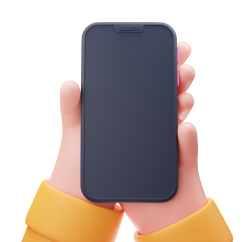
Got a Project? Tell us about it!
We are a leading custom software development agency focused on web, mobile app development & SaaS application development & MVP Development.
Everything you Need to Know About Flutter Development
- Mobile app development
Our experienced team of UX/UI designers and developers will help you stand out with a beautifully designed UX/UI.
Everything you Need to Know About Flutter Development
 The technological world is changing at a rapid pace as new technologies emerge and fall out of favor. If you've been following the mobile development scene, you've probably come across a useful technology called Flutter. What is Flutter programming language, and how can it be used in mobile development projects? In this article, we will be discussing everything you need to know about Flutter development tools, how to choose a Flutter development company and the cost of a Flutter development project.
The technological world is changing at a rapid pace as new technologies emerge and fall out of favor. If you've been following the mobile development scene, you've probably come across a useful technology called Flutter. What is Flutter programming language, and how can it be used in mobile development projects? In this article, we will be discussing everything you need to know about Flutter development tools, how to choose a Flutter development company and the cost of a Flutter development project.
What is Flutter Development
Google's Flutter is a free and open-source mobile UI framework that was published in May 2017. In a nutshell, it enables you to construct a native mobile application with a single codebase. This implies that you can design two distinct applications using a single programming language and codebase (for iOS and Android).Our experienced team will help you stand out with a bespoke, flexible, and scalable software application for your business.
Flutter Development Framework
Flutter is consists of two major components:- An SDK (Software Development Kit), which is a collection of tools that will assist you in developing your apps. This comprises compilers and tools for compiling your code into native machine code (code for iOS and Android).
- And a Widget-based UI Library), which is a collection of reusable UI components (buttons, text inputs, sliders, and so on) that you may modify for your requirements.
How To Start Flutter Development Project
 Flutter is a simple technology for app development. So, at the time of writing, we focused on both novices and experts, and we tried to keep this tutorial simple, organized, and straightforward. So, whether you work as a freelancer or for an app development company, this tutorial will help you become a better Flutter developer. This tutorial will look at Flutter Development for the Android Platform, but keep in mind that you will need Android Studio for Android and XCode for iOS.
So, before you begin the app development process, you should set up an environment. First and foremost, ensure that you have Android Studio 3.0 or later. If you do not have this, then simply follow the steps below:
Flutter is a simple technology for app development. So, at the time of writing, we focused on both novices and experts, and we tried to keep this tutorial simple, organized, and straightforward. So, whether you work as a freelancer or for an app development company, this tutorial will help you become a better Flutter developer. This tutorial will look at Flutter Development for the Android Platform, but keep in mind that you will need Android Studio for Android and XCode for iOS.
So, before you begin the app development process, you should set up an environment. First and foremost, ensure that you have Android Studio 3.0 or later. If you do not have this, then simply follow the steps below:
Step 1: Install Android Studio
For Flutter, Android Studio provides a fully integrated IDE experience. Furthermore, the Flutter SDK can be used for any text editor development experience. However, IDEs include features such as syntax highlighting, code completion, and a debugger that are extremely useful during the development process. Because we're concentrating on Android, professionals are advised to use Android Studio. Alternatively, you can use the IntelliJ Flutter plugin:- IntelliJ IDEA Community, version 2017.1 or later
- IntelliJ IDEA Ultimate, version 2017.1 or later
Step 2: Install the Flutter and Dart plugins
Install the following to begin a new project on your own or with the assistance of a software development company:- Launch Android Studio.
- Open the plugin preferences (on macOS, select Preferences> Plugins; on Windows and Linux, select File>Settings>Plugins).
- Open the plugin preferences (Configure>Plugins if you're using v3.6.3.0 or later).
- Browse the Flutter plugin repositories and click Install.
- When prompted to install the Dart plugin, select Yes.
- When prompted, select restart.
Step 3: Create a Flutter Project.
Select Flutter Application> Start a New Flutter Project> Android Studio to create a new flutter project. After selecting the Flutter Application, you will be prompted to enter the Flutter SDK path and basic project information on the following screen. As an example, if you're creating a Songs App, you'll need to fill out the following columns: Song_App, /home/user/flutter , /home/user/AndroidStudioProjects , Songs Gallery
As an example, if you're creating a Songs App, you'll need to fill out the following columns: Song_App, /home/user/flutter , /home/user/AndroidStudioProjects , Songs Gallery
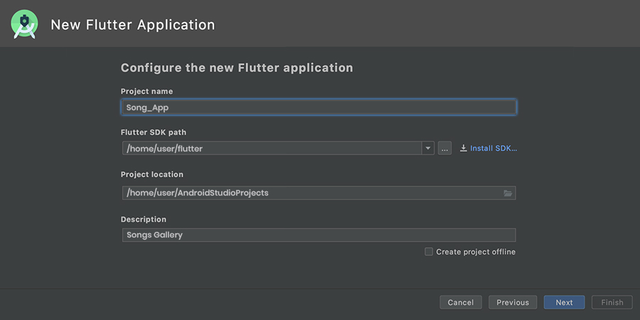 Finally, give the package a domain name. You must give the package a distinct name (for signing and publishing purposes). If you don't have a domain, you can use com.github.<your login> instead. Also, leave the other options at their default settings and click Finish to confirm. Hurray! Our project has been completed!
Finally, give the package a domain name. You must give the package a distinct name (for signing and publishing purposes). If you don't have a domain, you can use com.github.<your login> instead. Also, leave the other options at their default settings and click Finish to confirm. Hurray! Our project has been completed!
Step 4: Run the Build: Flutter Doctor
To ensure that your app's environment is properly set up, open the terminal (Alt+F12 in Android Studio) and run the Flutter Doctor command. To make it work, you must have at least a usable Flutter with one working IDE and a connected device (physical or emulator).- Testing Build on Android
 Keep the default settings as they are on the screen. It's finally time to put your app to use. Simply select the desired device or emulator and press “Shift+F10.” Alternatively, press the run button. When you click the run button, the icon below will change automatically.
Keep the default settings as they are on the screen. It's finally time to put your app to use. Simply select the desired device or emulator and press “Shift+F10.” Alternatively, press the run button. When you click the run button, the icon below will change automatically.

- Testing an App on iOS
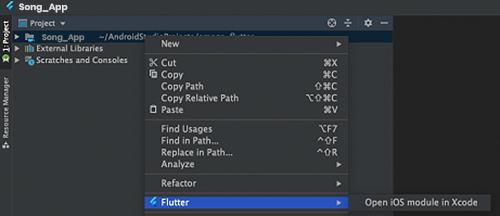 After you've opened Xcode, navigate to the app's signing and capabilities settings. Sign in with your Apple ID, and the provisioning profile will be generated after you close the Accounts window. If you encounter an error stating that the app identifier cannot be registered, it means that someone else is already using the identifier. Change the Bundle Identifier value here to something else. After you've configured the signing, you can try to run the app from Android Studio.
Because the provisioning profile on the device is not trusted, the first attempt will fail. While testing your app on iOS devices, keep in mind that Flutter apps provisioned with Personal Team provisioning profiles cannot be run on devices running iOS 13.3.1. This restriction was imposed by Apple. After you have trusted the profile, you can launch the app from the home screen. Because testing on iOS devices is quite complicated, it makes sense to hire an app developer who has all the necessary expertise and knowledge.
After you've opened Xcode, navigate to the app's signing and capabilities settings. Sign in with your Apple ID, and the provisioning profile will be generated after you close the Accounts window. If you encounter an error stating that the app identifier cannot be registered, it means that someone else is already using the identifier. Change the Bundle Identifier value here to something else. After you've configured the signing, you can try to run the app from Android Studio.
Because the provisioning profile on the device is not trusted, the first attempt will fail. While testing your app on iOS devices, keep in mind that Flutter apps provisioned with Personal Team provisioning profiles cannot be run on devices running iOS 13.3.1. This restriction was imposed by Apple. After you have trusted the profile, you can launch the app from the home screen. Because testing on iOS devices is quite complicated, it makes sense to hire an app developer who has all the necessary expertise and knowledge.

Step 5: Start Developing The Flutter App
Because you've already started a project called Song App. When you start coding the app, most app developers edit lib/main.dart, which contains the Dart code. You have the option of replacing the contents of lib/main.dart or removing all the code from lib/main.dart. Replace all the code with the code below, which displays "Songs Gallery" in the center of the screen.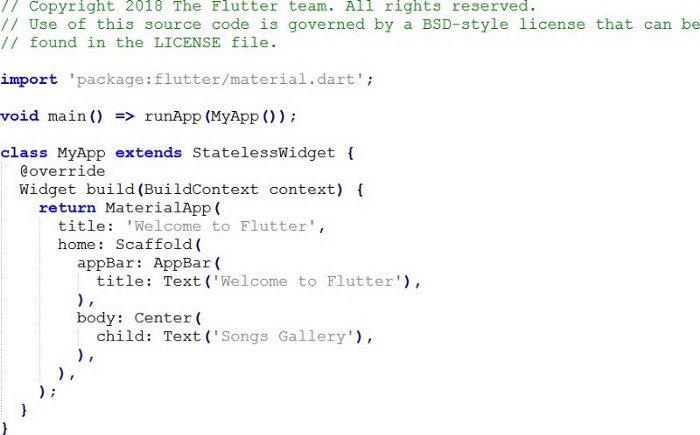 While pasting these codes into your app, use the tools mentioned in step 1 to fix this. Secondly, run the app by following the steps in step 4 and using the recommended Android and iOS IDEs for your devices.
While pasting these codes into your app, use the tools mentioned in step 1 to fix this. Secondly, run the app by following the steps in step 4 and using the recommended Android and iOS IDEs for your devices.
Step 6: Use an External Package
To keep your task organized and simple, you should start with an open-source package called english_words. Try to use common English words that are also functional. The english_words package and other open-source packages are typically found on Pub.dev by flutter app development companies. In lib/main.dart, import the new package: import ‘package:flutter/material.dart’; import ‘package:english_words/english_words.dart’; When you begin typing, Android Studio will begin to suggest libraries for you to import. It then turns the import string grey to remind you that the imported library has not yet been saved. Furthermore, instead of using the string "Songs_Gallery," use the English words package to generate the text.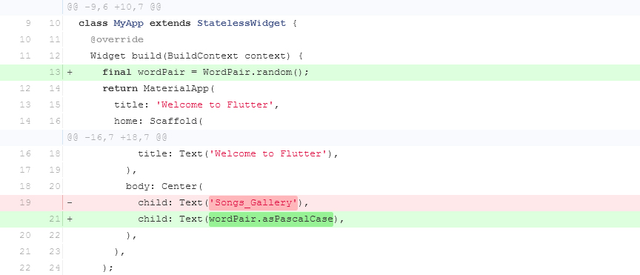 Following that, if the app is still running, you can use the hot reload feature to update the running app with the changes you made in the app. The image below shows the pair of words that were chosen at random to run in the app. If your app isn't working properly, check for typos or use Flutter's debugging tools. Most software development companies would prefer to use "pubspec.yaml" or “lib/main.dart” for debugging the app.
Following that, if the app is still running, you can use the hot reload feature to update the running app with the changes you made in the app. The image below shows the pair of words that were chosen at random to run in the app. If your app isn't working properly, check for typos or use Flutter's debugging tools. Most software development companies would prefer to use "pubspec.yaml" or “lib/main.dart” for debugging the app.
Our experienced team of android developers will help you stand out with a efficient and fast mobile app for your business.
Step 7: Include Stateful Widgets in your App.
Everything in Flutter app development is a widget, which is an application in and of itself. Stateless and stateful widgets have changeable and unchangeable conditions, respectively. The scaffold widget is a framework that contains all the standard screen components. Hierarchy can be a difficult process when you have an app bar, body, menu, and so on. Flutter's widget saves you a lot of time and effort when developing apps, but it requires a method to build a Widget. Other widgets should be included in the Widget. As a result, implementing a stateful widget necessitates the use of at least two classes: 1) a StatefulWidget class and; 2) a state class The StatefulWidget class is immutable and can be discarded and recreated. The State class, on the other hand, persists throughout the widget's lifetime. So, you'll need to add a RandomWordsState to the State class. To add _RandomWordsState as a child within the existing MyApp Stateless Widget, do the following:- Create the boilerplate code for a stateful widget by placing all the code in lib/main.dart and pressing Return a few times to start on a new line.
- As the name of your widget, type RandomWords. Both classes will now look like this:
 Make the changes reflected in the codes below to remove the word generation code from the app.
Make the changes reflected in the codes below to remove the word generation code from the app.
 Finally, restart the app to get it to behave normally and display a word pairing whenever you hot reload or save it.
Finally, restart the app to get it to behave normally and display a word pairing whenever you hot reload or save it.

Step 8: Create an Infinite Scrolling List View
Create a list of the most common words and add the option to mark the words that we liked the best and drag them onto the new screen to add some functionality. Essentially, the condition class contains the entire logic. So, here's the simple coding you'll need to do as a single class with comments: The app's final output will look like this:
The app's final output will look like this:
 Congratulations! You now know how to create an interactive Flutter app that works on both iOS and Android.
Congratulations! You now know how to create an interactive Flutter app that works on both iOS and Android.
Flutter Development Tools
We've compiled a list of the best Flutter app development tools for you to use to create efficient and user-friendly apps that meet your needs and satisfy your satisfaction levels. So, let's get started on the list!1. Panache
Panache is regarded as one of the best Flutter app development tools that developers rely on. It allows you to create personalized material themes for your Flutter apps. You can customize the shapes, colors, and other theme properties before exporting it as a.dart file to your Google Drive folder. You can use this tool to personalize and download the theme to create some eye-catching themes and materials for your software. This tool is currently used by over 40 million testers and developers. Furthermore, after completing the entire coding structure, you can evaluate the codes.Our experienced team of Flutter and React-native developers will help you stand out with an efficient and fast mobile app for your business.
2. Supernova
Supernova recently released Flutter Interact support for the Flutter platform. This tool assists you in writing Flutter UI code. Its material design widgets incorporate style and token ideas into a Flutter app. You can use Supernova to run two Flutter apps side by side, and changes are made in real-time. Furthermore, Supernova can save you time by importing your Adobe XD or Sketch file. Select Flutter as the export platform for converting the UI design to production-ready code.3. Count.ly
This open-source analytics tool prioritizes data privacy and security. The free version of Count.ly allows you to track the fundamental KPIs and metrics that show how an application is performing; however, a paid version with an expanded set of metrics and other features is also available. The paid version of Count.ly can be hosted in the cloud or on-premise, in addition to feature flags, push notifications, and A/B testing capabilities.4. Test Magic
Although it is a tool, it also serves as a free mobile app for testing and deploying iOS and Android beta releases. Test Magic makes it simple to download and deploy CI/CD builds on connected devices. You can collect screenshots and feedback and upload them to improve the app's functionality. You can also use it to connect to Codemagic, add test gadgets, and manage provisioning profiles for iOS debug builds.5. Codemagic
Consider Codemagic, one of the most effective Flutter app development tools. When you use the Flutter framework, it helps to improve your app-building process. Cinemagic will help you examine and launch applications using Codemagic. You can also market your app without any difficulty or complexity. If you use Codemagic, you won't need to configure your app to launch it in the market. You can also use its automation feature to test and create your product. It even simplifies the launching procedure by doing it efficiently.6. Adobe Plugins
Adobe has announced the new plugin at the Flutter Interact event. Adobe XD facilitates the developer's access to the designer's workflow. The Adobe Plugin generates Dart code for design components, which you can then insert into your app's codebase. In addition, Adobe XD and other plugins will be added to the platform in the future. As a result, you can make better use of this platform by utilizing the available plugins to create engaging and appealing applications.7. Instabug
Instabug is the ideal platform for real-time contextual understanding in mobile apps. It can be used by Flutter app developers for in-app crash reporting, bug reporting, feature requests, and surveys. With the integration of the Instabug Flutter SDK in your app, you can allow users to report bugs without leaving the application. Instabug takes a screenshot, which users can then annotate and blur. Furthermore, it collects detailed device information and logs to assist you in discovering and resolving issues more quickly. It also sends crash reports with all device details and logs to assist you in resolving the problem. Furthermore, you can send targeted surveys to your users to gain a better understanding of the motivations behind their actions and assist them in requesting and voting on features.8. RevenueCat
It's a tool for managing subscriptions and in-app purchases that work with Stripe, Android, and iOS. You can easily create and manage subscriptions and in-app subscriptions with RevenueCat, which handles all the heavy liftings and manages the billing infrastructure. Furthermore, it assesses churn, MRR, LTV, and other unusual metrics to determine how well an application is performing.9. Appetize
Appetize is a web-based app development platform that is ideal for Flutter app development. It enables you to quickly launch your apps on the iOS and Android platforms. If a user accesses the browser in JavaScript or HTML format, it also aids in the performance of native apps on mobile devices. Furthermore, Appetize makes it easy for both users and developers to keep track of their apps. As a result, if you create a Flutter app, you can use it to make the installation process more efficient and straightforward.10. Sylph
Maurice McCabe created this open-source command-line tool, which is essentially a wrapper around the AWS Device Farm. Sylph allows you to run end-to-end tests and Flutter integration on multiple real Android and iOS devices in the AWS Device Farm at the same time.11. Visual Studio Code
Visual Studio Code is used by Flutter developers for task execution, version control, and the creation and debugging of cloud and web apps. This open-source and free code editor was created by Microsoft for macOS, Windows, and Linux. Smart code completion, debugging support, snippets, syntax highlighting, code refactoring, and embedded GIT are all included. Visual Studio Code is powerful and lightweight, but it cannot handle complex workflows that are handled by full-featured IDEs such as Visual Studio IDE. It is fully compatible with C++ and Python. It is efficient and simple to use.12. Screenshots
Screenshot, a command-line utility that comes with one of the most efficient IDEs for Flutter app development, allows you to capture screenshots. It also allows you to directly upload them to the status bar. And you can easily incorporate these screenshots into your Flutter app. These integrated screenshots are also compatible with the iOS and Android platforms. As a result, it appears to be one of the best Flutter app development tools that developers adore.13. Android Studio
Android Studio is used by many developers who use the Flutter platform to create apps. And this is one of the most productive IDEs for creating effective apps. It supports widget editing, syntax highlight procedures, and code completion. Furthermore, it allows you to create and run applications on an Android device or emulator without the need to download and install the Android Studio.14. AppsFlyer
This mobile attribution tool assists you in determining where your users are coming from and assigning application installs to specific marketing campaigns. It also allows you to see how your marketing campaigns and channels are performing across devices and applications in a single dashboard, and it integrates with over 6000 media partners.15. Amplitude
This popular in-app analytics tool provides information about how your users interact with your application. At the moment, it's a well-known Flutter developer tool that allows you to monitor and track a wide range of data and integrates with every well-known mobile app-building platform to allow you to take actions based on your data.16. Firebase
It aids in the integration of the Flutter application and the release of apps on the Android and iOS platforms. Firebase APIs can be combined in a single SDK, and this is how the backend can be unified. Firebase has several features, including crash reporting and messaging.17. Airship
This is a client engagement platform that allows you to engage your users and increase their conversion by sending in-app messages and push notifications to them. Furthermore, it allows you to create an in-app message center, which creates an in-app inbox from which you can send continuous messages to all users.18. Square
This in-app payment handling platform handles all the complications associated with payment processing for you. Using its Flutter SDK, you can start accepting in-app payments through an easily customizable user interface that supports stored cards and online wallets for quick checkout.19. Vysor
Vysor makes it simple to mirror a device's screen activities onto a computer. You can accomplish this with a USB cable. A data connection may not be required for this. To use this, you must first install the Vysor Chrome extension.20. WonderPush
This is yet another in-app messaging and pushes notification tool that can be used in a Flutter app. It increases app user engagement. For a low cost, it offers a plethora of robust features such as targeting and segmentation, A/B testing, and geo-targeting.The Cost of Flutter Development Project
The cost of app development is a complex number that depends on a variety of factors, including the complexity of features, the location of developers, supported platforms, and more. It is impossible to determine the cost of your project without conducting research and understanding all the requirements. Mobirevo conducts a discovery phase to determine our clients' desires and requirements. You can still look at our estimates sorted by project complexity.- A fitness app with workout suggestions, meal plans, a personal profile, and a weight diary costs between $26,000 and $34,800.
- The cost of developing a Flutter app for a medium-complexity software, such as a messenger with voice calls, will range between $34,950 and $48,850.
- The development of a complex app, such as Instagram, will cost you between $41,500 and $55,000.
How to Choose a Flutter Development Company
 Choosing a mobile app development company to help you meet the demands of your product idea is a difficult task. The chosen company should have extensive experience and offer reasonable prices for its services. Before you begin your search for a development partner, you should think about a few things.
Choosing a mobile app development company to help you meet the demands of your product idea is a difficult task. The chosen company should have extensive experience and offer reasonable prices for its services. Before you begin your search for a development partner, you should think about a few things.
1. Identify Your Exact Business Requirements:
You must be aware of your business expectations, as we have repeatedly stated. What you want to achieve, how you want to achieve it, and why you want to do it. Before approaching a potential app development company, you should have clear answers to these questions. The roadmap should at the very least be understandable so that the solutions do not come as a surprise. Some pertinent questions to consider are:- Which platform do you want to focus on?
- Which features do you want to include?
- Who are your ideal clients?
- What do you hope to accomplish with this app?
2. Define Your Budget:
You must specify how much money you intend to invest in app development. It is preferable to consult with your prospective mobile development company about this. Obtain quotes from various companies and compare the costs and services offered. You can also conduct an internet search to see what other companies charge. However, keep in mind that the cost of development will vary depending on the developing country.3. Make A Shortlist Of Possibilities:
Now that you have a better understanding of the industry, it is time to start looking for options. You can get some references from your friends and family. Make a list of the companies you've been given and begin visiting their websites. Keep an eye out for any minor details and make a note of any noteworthy observations. Examine their portfolios, web design, and services. This way, you'll be able to create a shortlist of companies from which to select one later.4. Check The Company's Size:
While this exercise has little impact on the selection, it's always a good idea to do some preliminary research on it. The manpower information indicates whether they can handle a project of your size. Because a company with fewer employees may become overburdened with work, lowering the quality of applications. It would also be fantastic if you could learn about the development team's skill set. You can set realistic expectations if you understand the background of the skillset.5. Ensure Pricing And On-Time Delivery:
It may appear too simple, but you must inquire about their turnaround time. This is because they do not disappoint you by making up excuses. If you don't want to ask them directly, you can look at their online reviews. Check to see if they have been reported for failing to meet deadlines. Check to see if they have a good team and a time-management strategy in place. Having said that, a quick turnaround time does not imply that the company charges a premium. Make your budget constraints very clear to them from the start of the conversation.6. After Support:
We've said it before, and we'll say it again: the development company's job doesn't end when the product is delivered; it extends beyond that. Pitfalls under their responsibility to attend to all future support queries. When you confront them with technical issues, they should gladly address them. Inquire if they offer upgrade services.7. Examine The Reputation:
With businesses going online, it is much easier to find out specific information about a company or even a person. As a result, conduct extensive research on your potential development partner. Follow their social media pages to learn more about their working style. Examine the testimonials and reviews available on various online platforms.Conclusion
Flutter is gaining popularity as a cross-platform mobile application development framework, and developers are eager to get started. We hope this guide serves as a good starting point for your first Flutter project. Are you looking for a Flutter expert team? Don't look any further! Our Flutter experts at Mobirevo understand how to make the most of this technology in a mobile development project. Get in touch with one of our consultants to find out how Flutter can help you take your project to the next level. You can contact us today to get a free quote. Our team at Mobirevo strives to provide unrivaled services to all of our valued clients. You can also check out our case study page to see our client's portfolio and get a better understanding of the quality of products we deliver. Also, contact us if you have any questions about our services, and we will get back to you as soon as possible. Want to receive more content like this? You can sign up for our newsletter, which features curated opinions, and Mobile app development tools for building remarkable digital assets. If you sign up for our weekly newsletter, you will be the first to know when we publish awesome content like this. You can also visit our blog to see other content created with love by our amazing team.[ultimate-faqs include_category='Everything you Need to Know About Flutter Development']
Got a Project? Tell us about it!
We are a leading custom software development agency focused on web, mobile app development & SaaS application development & MVP Development.
Subscribe to Our Newsletter
Join over 5,000 enterpreneurs and businesses who already have a head start.
Got a Project? Tell us about it!
Our Engagement Models
OUR PRESENCE
BLOCKCHAIN
OTHER SERVICES WE OFFER
CONTACT
Copyright © 2022 Mobirevo Software & Technologies LTD a company duly registered with CAC with RC Number: 1756190. All rights reserved.

Got a Project? Tell us about it!
We are a leading custom software development agency focused on web, mobile app development & SaaS application development & MVP Development.

